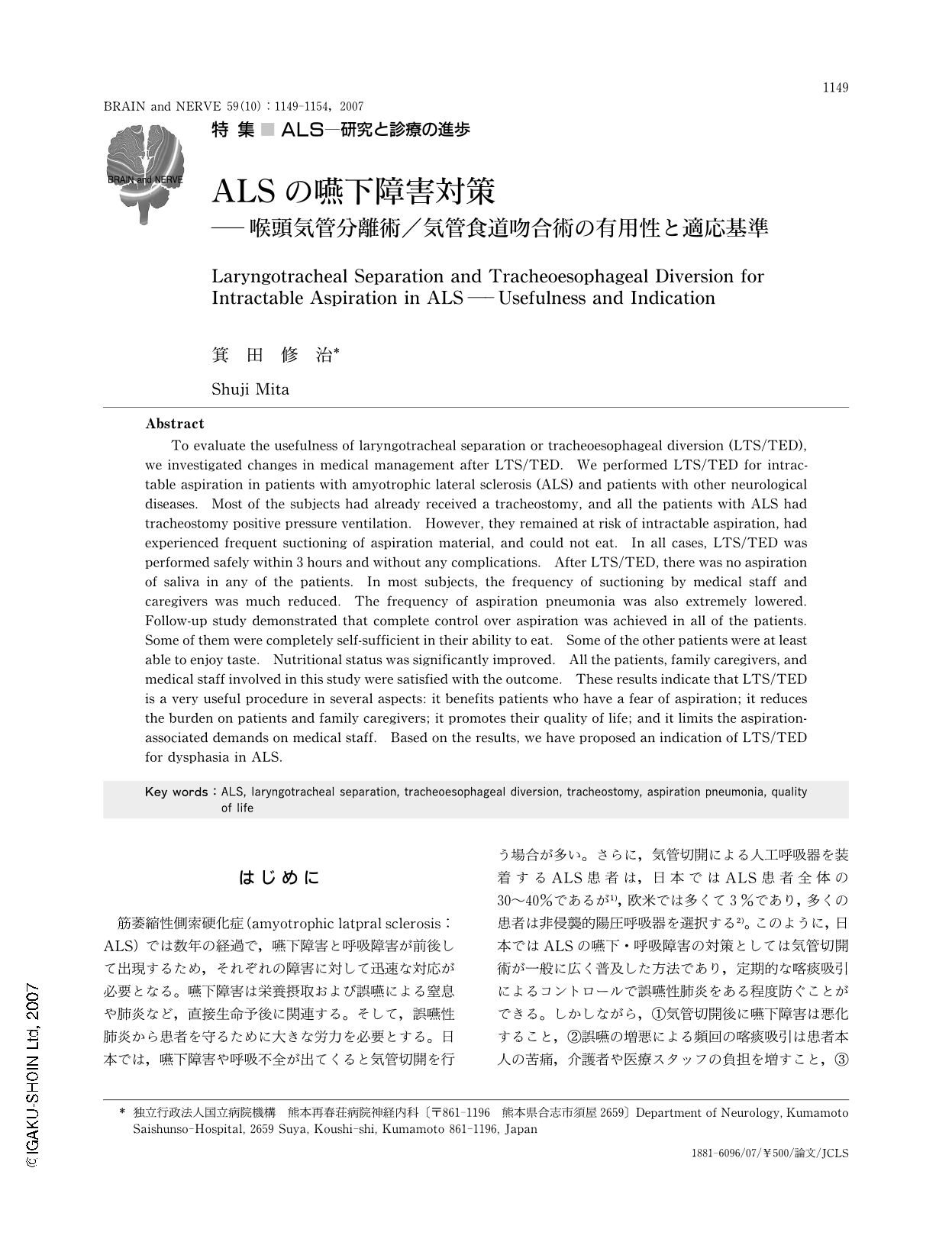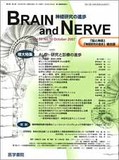Japanese
English
- 有料閲覧
- Abstract 文献概要
- 1ページ目 Look Inside
- 参考文献 Reference
はじめに
筋萎縮性側索硬化症(amyotrophic latpral sclerosis:ALS)では数年の経過で,嚥下障害と呼吸障害が前後して出現するため,それぞれの障害に対して迅速な対応が必要となる。嚥下障害は栄養摂取および誤嚥による窒息や肺炎など,直接生命予後に関連する。そして,誤嚥性肺炎から患者を守るために大きな労力を必要とする。日本では,嚥下障害や呼吸不全が出てくると気管切開を行う場合が多い。さらに,気管切開による人工呼吸器を装着するALS患者は,日本ではALS患者全体の30~40%であるが1),欧米では多くて3%であり,多くの患者は非侵襲的陽圧呼吸器を選択する2)。このように,日本ではALSの嚥下・呼吸障害の対策としては気管切開術が一般に広く普及した方法であり,定期的な喀痰吸引によるコントロールで誤嚥性肺炎をある程度防ぐことができる。しかしながら,①気管切開後に嚥下障害は悪化すること,②誤嚥の増悪による頻回の喀痰吸引は患者本人の苦痛,介護者や医療スタッフの負担を増すこと,③それでもなお誤嚥性肺炎のリスクを伴うこと,誤嚥性肺炎のリスクから経口摂取を断念せざるを得ず,食の楽しみを失ってしまうこと,など問題点も多い。このような患者に対して,さらなる対策として気道と食道を完全に分離することで誤嚥を防止する誤嚥防止術がある3)。日本神経学会によるALS治療ガイドラインでは,栄養管理の中で,嚥下障害が進行した時には,食物道とともに同時に呼吸道を形成する気管分離・食道吻合術や喉頭摘除術の選択も行われる4),との簡単な記載があるが,アメリカ神経アカデミー学会のALS治療指針では,気管切開による人工呼吸器装着についての記載はあるものの,誤嚥防止術についての記載はまったくない5)。実際,多くの神経内科医は誤嚥防止術の詳細について,十分な知識をもっておらず,ALSをはじめとする神経難病における誤嚥防止術の有用性や,患者・家族の満足度を評価した研究はごく少数である6,7)。
筆者らは神経難病患者に対する誤嚥防止術として,喉頭気管分離術または気管食道吻合術(喉頭気管分離術/気管食道吻合術)を施行し,その有用性について検討してきた8,9)。喉頭気管分離術/気管食道吻合術は,ごく一部の病院で嚥下障害のため誤嚥性肺炎を繰り返し起こす重症心身障害児,脳血管障害患者や成人神経難病患者に試みられている程度である10-12)。ここでは,ALS患者における有用性,誤嚥防止術の適応基準とアルゴリズム(手段決定の手順)について述べる。これは,そのほかの神経難病患者についても同様に適用できるものである。
Abstract
To evaluate the usefulness of laryngotracheal separation or tracheoesophageal diversion (LTS/TED), we investigated changes in medical management after LTS/TED. We performed LTS/TED for intractable aspiration in patients with amyotrophic lateral sclerosis (ALS) and patients with other neurological diseases. Most of the subjects had already received a tracheostomy, and all the patients with ALS had tracheostomy positive pressure ventilation. However, they remained at risk of intractable aspiration, had experienced frequent suctioning of aspiration material, and could not eat. In all cases, LTS/TED was performed safely within 3 hours and without any complications. After LTS/TED, there was no aspiration of saliva in any of the patients. In most subjects, the frequency of suctioning by medical staff and caregivers was much reduced. The frequency of aspiration pneumonia was also extremely lowered. Follow-up study demonstrated that complete control over aspiration was achieved in all of the patients. Some of them were completely self-sufficient in their ability to eat. Some of the other patients were at least able to enjoy taste. Nutritional status was significantly improved. All the patients, family caregivers, and medical staff involved in this study were satisfied with the outcome. These results indicate that LTS/TED is a very useful procedure in several aspects: it benefits patients who have a fear of aspiration; it reduces the burden on patients and family caregivers; it promotes their quality of life; and it limits the aspiration-associated demands on medical staff. Based on the results, we have proposed an indication of LTS/TED for dysphasia in ALS.

Copyright © 2007, Igaku-Shoin Ltd. All rights reserved.


